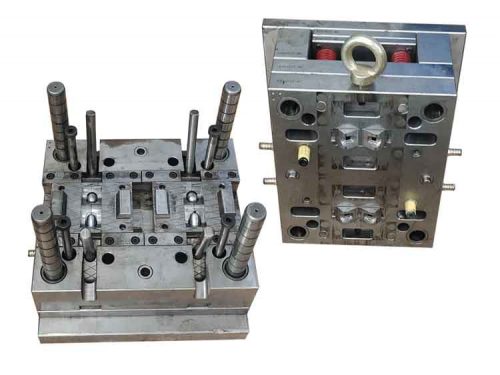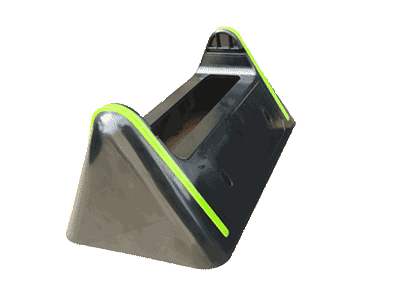Understanding Overmolding: Applications, Challenges, and Best Practices
Overmolding, also called plastic overmolding, molding over molding, or injection overmolding, is a crucial injection molding technique widely used in everyday items like toothbrushes, power tool housings, and car light panels. This article will explain overmolding, highlighting its common challenges and essential precautions.
Understanding Overmolding
Overmolding is a process where a substrate, typically a pre-formed plastic part, is placed inside a mold. During the process, molten plastic is injected into the mold cavity, enveloping the substrate in the empty areas. Once cooled, the two materials fuse into a single product.
Although insert molding and 2-shot molding fall under overmolding, they are often referred to separately. In a narrower definition, overmolding specifically involves a plastic substrate manually placed into the mold.
Materials for Overmolding
Commonly, the substrate in overmolding is a hard plastic like PA or PC. The overmolded material, however, can be a flexible plastic such as TPE or TPU, or even another hard material.
It’s crucial that the overmolding material has a melting point equal to or lower than the substrate’s. Using the same material for both is possible, but it requires careful adjustment of the injection molding temperature to prevent the substrate from partially melting.
Multi-shot Overmolding
Overmolding usually involves a single overlay, requiring two injection molds. The final product is a combination of two materials or two color variations of the same material.
There are instances of double overmolding as well, which necessitates three molds, resulting in a product composed of three materials or color variations.
While theoretically, overmolding can be repeated multiple times, such practices are rare in real-world applications and are not the focus of this discussion.
Overmolding vs. Insert Molding
Insert molding typically involves inserting pre-fabricated parts, often made of metals like copper or stainless steel, into an injection mold. These parts can also be made from other materials such as glass, wood, or fiber.
In contrast, overmolding utilizes a previously injection-molded product (the substrate).
From this distinction, it’s evident that insert molding usually requires just one injection mold, whereas overmolding necessitates at least two, and occasionally three, molds.
Overmolding vs. 2-Shot Molding
Automatic for 2-shot molding
2-shot molding combines both substrate molding and overmolding in a single injection molding machine. Here, after the substrate is molded, it’s rotated to another station within the same machine for overmolding, eliminating the need to manually transfer the substrate.
This process can even extend to 3-shot molding, particularly in some automotive products, though this is less common.
Manual for overmoldng
In traditional overmolding, the substrate is first injection molded, removed from the mold, and then manually placed into another mold for overmolding.
Advantages for 2-shot molding
This makes 2-shot molding more efficient and labor-saving. Additionally, since the substrate remains hot during overmolding in 2-shot processes, it often results in a stronger bond between the substrate and overmolding material.
Choosing the Right Option Based on Production Volume
However, 2-shot molding requires highly precise molds and thus involves greater initial investment costs. Therefore, the choice between these methods depends on the production volume:
- For large-scale production, 2-shot molding is preferable due to its shorter cycle time, stable quality, and reduced labor requirements.
- For smaller production runs, overmolding is recommended to minimize mold investment costs.
Pros and Cons of Overmolding
Overmolding is a widely used plastic molding process with many advantages but also some limitations. Here are the main pros and cons of overmolding:
Advantages
- Enhanced Comfort and Grip: Adding a soft plastic layer over hard plastic parts improves product comfort and grip, particularly suitable for frequently held components like handles.
- Improved Aesthetics: Overmolding combines different colors and materials to create attractive appearances and textures.
- Increased Durability and Impact Resistance: The soft outer layer absorbs shocks, protecting internal hard components and enhancing overall durability.
- Reduced Assembly Steps: This process integrates multiple parts into one, reducing assembly work later.
- Enhanced Slip Resistance: The soft plastic surface layer improves product slip resistance, ideal for products requiring a non-slip grip.
- Versatility: Different material combinations can give products a variety of physical and chemical properties.
Disadvantages
- Higher Costs: Overmolding requires more complex molds and longer production times compared to traditional single-material injection molding, potentially leading to higher costs.
- Design Constraints: The design must consider the compatibility and adhesion between two materials, which may limit design freedom.
- Material Selection Limitations: Not all materials are suitable for overmolding; a combination that adheres well must be chosen.
- Production Complexity: This process is more complex than single-material injection molding, requiring higher technical skill and more precise production control.
- Recycling Challenges: Products containing multiple materials can be more difficult to recycle and reuse.
In summary, while overmolding technology offers enhanced functionality and aesthetics, it also brings challenges in cost, design, and material selection.
Common Materials and Their Uses in Overmolding
1. Soft and Hard Material combination
The substrates in over-molding often include materials like PA, PC, ABS/PC, and ABS, while TPE, TPU, TPR, and TPO are common choices for the overmolding layer. This blend of soft and hard plastics represents the most typical form of overmolding.
2. Multi-color plastic component
It’s also possible to use hard plastics for both the substrate and the overmold, usually the same material, often employed in multi-color combinations for aesthetic appeal.
Exceeding the limitation of wall thickness
Additionally, in scenarios where the maximum thickness of an injection-molded product is exceeded, a two-shot injection molding process may be used. This approach ensures each individual molding stays within the maximum allowable thickness.
Theoretically, the possibilities extend beyond these mentioned materials. Essentially, any plastic can be used for over-molding. For specific requirements, please feel free to contact us for more information.
Common Issues in Overmolding and Solutions
Poor Adhesion: This issue often arises due to incompatibility between materials. For different materials, compatible overmolding materials must be selected. Additionally, a low temperature of the substrate’s surface can lead to poor adhesion. On the other hand, excessively strong adhesion can create recycling challenges for the product.
To mitigate adhesion issues, it’s common to design holes or grooves at the edges of the overmolded area. These features, being larger internally, help to lock the overmold in place and reduce the reliance on adhesive strength, making it easier for the overmold to bond with the substrate.
Short Shot: Even a slight inadequacy in the injection can cause aesthetic defects, leading to product rejection. It’s crucial to design the gate location thoughtfully to prevent short shots. A Design for Manufacturability (DFM) assessment can be used to evaluate the suitability of gate placement, focusing mainly on the required injection pressure.
Flash: Excessive gaps between the mold cavity and the substrate can lead to flash (excess plastic). Moreover, if the gate design is improper, leading to excessive injection pressure (to avoid short shots), it can also result in flash.
Key Considerations in Making Overmolding Mold
Creating molds for overmolding requires higher precision and a thorough understanding of the overmolding materials. The following are essential aspects to consider in overmolding mold design:
Precision Fit Between Substrate and Mold: The fit between the substrate and the mold cavity in overmolding needs to be very precise. The gap between the substrate and the mold cavity after inserting the substrate should be between 0.01 to 0.03mm. This precision is crucial because materials like TPE, known for their fluidity, can easily cause flash if the gap is too large.
Conversely, a gap that is too small or negative, such as -0.01 to -0.02mm, can create indentations on the substrate surface. Therefore, the mold must be manufactured with high accuracy.
Gate Design in Overmolding: The design of the gates in overmolding molds is highly critical. They must ensure complete filling while maintaining sufficient adhesive force. The key is to ensure that all areas to be overmolded are not too far from the gates. This is to avoid insufficient injection pressure or too low temperatures in those areas, which could affect the quality of the over molding.

Conclusion
In conclusion, overmolding is a versatile and widely used plastic molding technique that enhances product functionality and aesthetics. Despite its complexity, with proper material selection, precise mold design, and attention to key issues like adhesion, short shots, and flash, overmolding offers significant benefits.
Understanding the nuances between overmolding, insert molding, and 2-shot molding is crucial for selecting the right process for specific applications, balancing efficiency, cost, and production volume.




